Cards on the table, the global tech talent market is wild. Mass layoffs top the news headlines. Google, Yahoo, Criteo, Infosum, Taboola, Unity, and AppLovin’ among others, substantially reduced their headcounts since the start of 2023.
Although AdTech companies are letting go of the high-caliber tech workforce, talent acquisition has not become easier. In the US, the unemployment rate is at 3.4%—the lowest since 1969. In the UK, 95% of employers looking for tech talent faced skills shortages. European markets aren’t doing much better.
The best tech people don’t stay out of work for long. A ZipRecruiter survey found that 8 in 10 laid-off tech employees in the US found a new job within 3 months of their search; 40% did so in one month. Moreover, tech salaries will remain in six digits across the US. This means belt-tightening AdTech companies may not be able to snatch the newly available talent that fast.
Though engineering teams became smaller, the workload didn’t vanish proportionally. AdTech companies are still pressed to deliver results fast, especially as the industry continues to evolve rapidly to prepare for the cookieless future.
So, how can AdTech companies maintain growth momentum amidst the disruption?
By considering outsourcing to complement your in-house team and reinforce product development strategy.
According to Marketing Science, over 4 in 5 (86%) CIOs surveyed said they will likely outsource any tech-related or other functions within their company’s technology department in the next six months, with just over a third (34%) saying it’s very likely.
In-house AdTech development vs outsourcing: What are the pros and cons?
In-house software development is the most straightforward approach for new product development (NPD).
Internal stakeholders come up with a product vision. A product management team formalizes the development plan, timeline, and budget. Then, you hire software engineers to get things cracking.
But the above is a “perfect” scenario.
In practice, only 62% of in-house software development projects are completed within the original budget and 55%—within the set timeline, according to a Project Management Institute (PMI) study.
An early McKinsey survey suggests that between 25% and 40% of digital programs exceed the original schedules or budgets by over 50%.
Project budgeting can be complex since you have to account for multiple cost centers: Labor costs, tech/infrastructure costs, and subsequent support + maintenance.
To illustrate this complexity, let’s take one of the market leaders as an example. The Trade Desk has over 2,700 global employees (with the total number increasing by 40.82% in 2022 compared to 2021). A median software engineer’s salary at the company stands at $213K annually. Assuming that IT makes up at least 30% of the total company workforce, that puts their possible payroll (alone) at over $17 million per year.
On top of employee salaries, you have to account for other overhead costs, including investments in employee perks, retention, training, and upskilling.
IT infrastructure costs are a second major expense line. For high-load MarTech/AdTech products, cloud computing costs alone can rise over $500K per month. Not to mention the spending on other premium tools such as software licensing costs, IT infrastructure monitoring tools, ITOM apps, and more. All of the above factors make new AdTech product development a big-ticket item.
Data-intensive MarTech/AdTech projects require a distinct architectural approach, smart cloud adaptation, effective resource utilization in the cloud, optimal tech stack, and suitable database management systems. When designing an architecture strategy, the engineering team should thoroughly dissect each part of the holistic optimization strategy to prepare their application for growth.
However, engineers without previous experience in high-load projects lack the knowledge necessary to design computation-intensive systems, predict database scaling patterns, and devise performance optimization strategies.
Timely technical audits and the guidance of consultants and engineers well-versed in high-load and big-data solution development can save businesses from radical revamps, costly experiments, and mistakes.
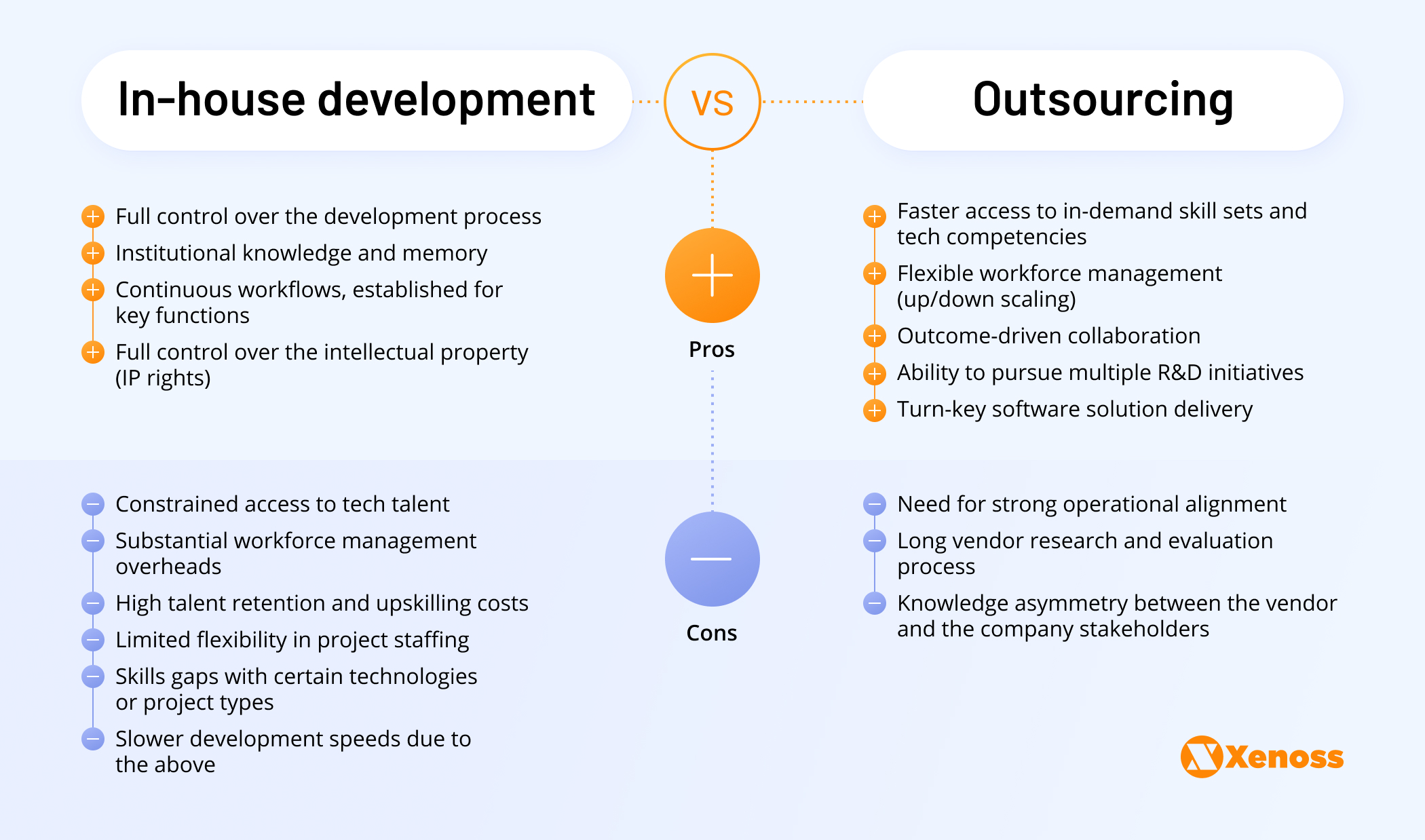
IT outsourcing as an alternative talent acquisition model
The premises are simple: A company delegates a project and/or a function to an external vendor, who commits to gathering a project team and delivering the results based on the pre-agreed requirements recorded in a Scope of Work (SoW) statement and/or a Master Service Agreement (MSA). Outsourcing, as a business growth strategy, has been around for decades.
Yet, in the last couple of years, outsourcing has evolved from hiring offshore teams for secondary business processes to building long-term strategic partnerships for core product development.
According to a Deloitte 2022 Outsourcing report, 76% of all respondents say that they’ve commissioned IT services from a third-party provider.
Unlike two years ago, cost optimization is no more the main reason for using outsourcing. Today, leaders rely on IT outsourcing to gain new capabilities, transform their operating model, and better keep up with the changing tech and regulatory requirements.

How a tech partner accelerates the development of an AdTech project
Innovative AdTech vendors partner with custom AdTech development companies to gain the capabilities and development speeds they need to create a growth momentum. Outsourcing software companies excel in achieving these goals because of their experience working with companies at different phases of development and in a multitude of scenarios.
Let’s investigate the typical situations where product and engineering teams turned to Xenoss for consultation and tech partnership.
Scenario 1: A client has a Proof of Concept for their solution and decides to outsource the development of their product.
The collaboration Xenoss had with Venatus is a textbook scenario for the AdTech industry. The client had a technically feasible and small-scale version of a product that should have been optimized for scalability.
Xenoss released a market-ready publisher monetization and advertising platform for gaming and entertainment within 4 months. Following our typical outsourcing protocol, we conducted a thorough technical audit of the tech stack and cloud infrastructure to identify potential issues and bottlenecks. As a result, Xenoss’ engineering team helped Venatus improve system performance by 10 times. These development implementations contributed to the following business results:
- the client grew their publisher list from 200 to 900
- we expanded the system’s capabilities to incorporate 10 more Google ad creative formats
- the platform extended its reach with +14 new ad networks
Scenario 2: A client doesn’t want to use white-label DSP or build their platform from scratch
This business challenge is exactly right up Xenoss’ alley, an AdTech software development house with its own AdTech low-code platform. A low code platform with ready-made components is a perfect solution for clients tied for time-to-market and budget.
This unique offering, a low-code platform, is exclusively available from vendors with profound AdTech expertise, as their extensive product-building background enables them to develop universal modules and components for optimal efficiency.
This approach allowed for an extremely fast start and quick delivery of MVP for our client, for whom Xenoss’ team released a complex demand-side platform (DSP) project within 14 weeks after the project kickoff. Apart from shipping the essential DSP features, Xenoss also delivered a state-of-the-art AI toolset and shipped 4 integrations with popular supply-side platforms (SSPs) — all while keeping the monthly system TCO below $200,000. With a smart adaptation of the existing AI toolset, we integrated a real-time prediction mechanism in the MVP. This DSP component ensured the above-market conversion rate.
Scenario 3: A client wants to transform its application into a more flexible and cost-effective solution with a well-optimized IT infrastructure
All the beauty of tech partnerships with outsourcing software companies is that they can pull off such ad hoc projects with unparalleled speed, a reduced need for manpower, and minimized client supervision. In just 4 months, Xenoss’ team of 6 AdTech/MarTech specialists completed a meticulous technical audit, solution overhaul, and infrastructure optimization. We also helped a programmatic ad marketplace, Powerlinks DSP, with an audience reach of 1 billion and 400,000 sites and apps reduce infrastructure costs by 20 times. By implementing a new cloud-based infrastructure design, Xenoss improved performance, scalability, and reliability while significantly reducing expenses for the marketplace.
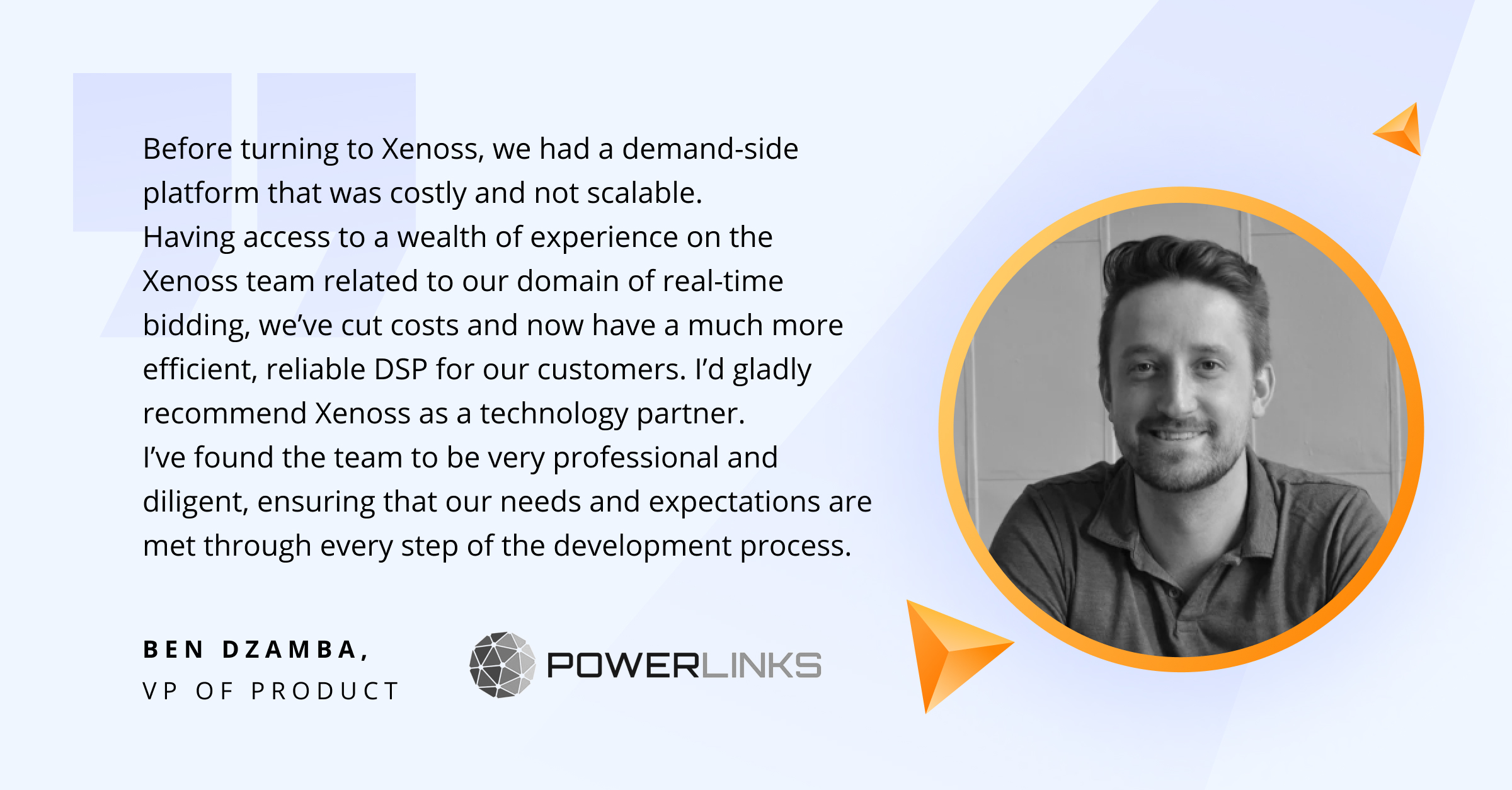
Three IT outsourcing models for AdTech software development
- Team augmentation. Accelerate time-to-market by augmenting your in-house workforce with external IT talent, fully integrated into your operations.
- White-labeling. Purchase and customize an existing AdTech solution with subsequent integration into your stack with the help of an implementation partner.
- Custom software development partnerships. Ship complex projects with a collaborative, skills-and-technology-powered partnership model between your company and a custom software development vendor.
Team augmentation
Team augmentation (also known as “staff augmentation” or “team extension”) is a classic outsourcing model used across functions — sales, marketing, customer support, and software engineering. Team augmentation assumes hiring skilled professionals via an outsourcing company to get the capacity or skills to tackle the required project.
In other words, instead of sourcing talent locally, you rely on a staffing partner to find, recruit, and onboard tech talent that meets your hiring criteria (specific skillsets, experience levels, qualifications, etc).
Despite layoffs, over 85% of technology leaders still struggle to find skilled talent in software and applications development, technology process automation, cloud architecture, and operations.
If you need people with specific skill sets for a short-term or long-term project, team augmentation may work best for you.
The right outsourcing partner can match you with the right people in a matter of days (not months), allowing you to start (and deliver!) the project faster. New team members can be added or removed from the project as needed. Compliance-wise, the talent remains on the vendor’s payroll, meaning you’re not footing any hiring or employment overheads.
However, remote AdTech developers are fully integrated into your company workflows and managed directly by you. In other words, you hire external talent to work alongside your core in-house team.
Think of team augmentation as the middle ground between hiring independent contractors locally and adding another payrolled employee. You get to benefit from the flexible staffing approach of the former and the dedication of the latter, but with fewer overhead costs and compliance complexities.
Rand Fishkin, co-founder of Moz and now SparkToro, is a big proponent of using an external workforce (consultants, agencies, staff augmentation firms) for software development.
In his words:
When I’ve hired agencies, productive work toward the project’s goal starts immediately. Time taken to understand your business, the problem, and any requirements are usually covered in the proposal period. Conversely, when I hire FTEs, there’s often a lengthy ramp-up to even half-productivity. In small teams, this might be as fast as a week or two, while in larger ones, it could be a month or more.
Team extension enables AdTech companies to streamline the path to profitability by maintaining lean, flexible engineering teams during the early growth stages. Then, progressively scaling the in-house (and outsourced) workforce size as the product gets traction.
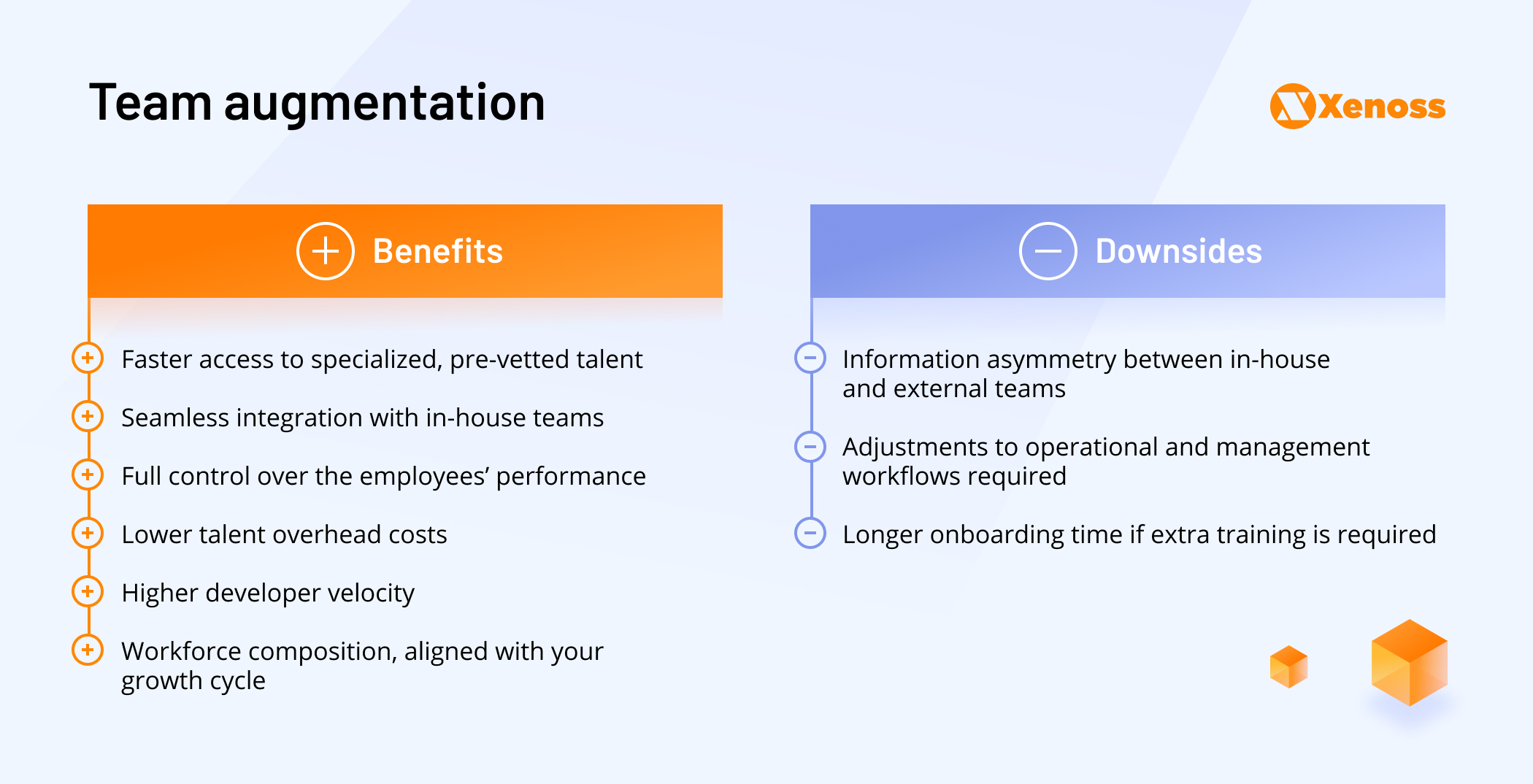
White-labeling AdTech solutions
White-labeling is another common sourcing strategy, but this time — for technology.
For instance, Walmart partnered with the Trade Desk to launch its own demand-side platform. Lowe’s built its Roof Media Network together with Criteo and CitrusAds. Numerous other players like Beeswax and Kayzen offer “as a service” access to their AdTech software solutions.
White-labeling deals also assume assistance with platform customization and ongoing management. Apart from “renting out” the technology, a vendor also hooks you up with a team of implementation consultants, who either work alongside your in-house team or do the heavy lifting themselves (a slightly less common scenario).
Ongoing platform support and extension tasks can also be handled by the licensing vendor (for a separate fee, of course).
For smaller AdTech companies, white-labeling can be a quicker go-to-market path. For example, My Code, a publisher network that specializes in multicultural media, delegated its SSP implementation and maintenance to PubMatic.
As Mark Murrin, My Code’s SVP of business development, explained in an interview with AdExchange, the company didn’t have a huge engineering team. So when they needed a new Prebid solution, My Code decided to bring external AdTech knowledge and technology. Since the company already has a close partnership with PubMatic on the SSP side, “outsourcing our ad tech to PubMatic’s engineering team made a lot of sense.”
By delegating the backend management of its tech stack, My Code has more resources to concentrate on other tech initiatives without disrupting its day-to-day operations.
That said, white-labeling MarTech/AdTech products come with inherent constraints:
- Limited functionality
- No control over the product development roadmap
- Heavy dependence on the vendor’s good graces and expertise
You may be limited in your ability to integrate new SSPs/DSPs if the white-label platform you use has in-built interoperability issues, which restrains your growth potential.
Moreover, white-labeling comes with a hefty initial investment. You have to spend a lot upfront to get the product running. Then, I hope you’ll quickly increase your revenues to cover the ongoing licensing and support fees (plus make money on top).
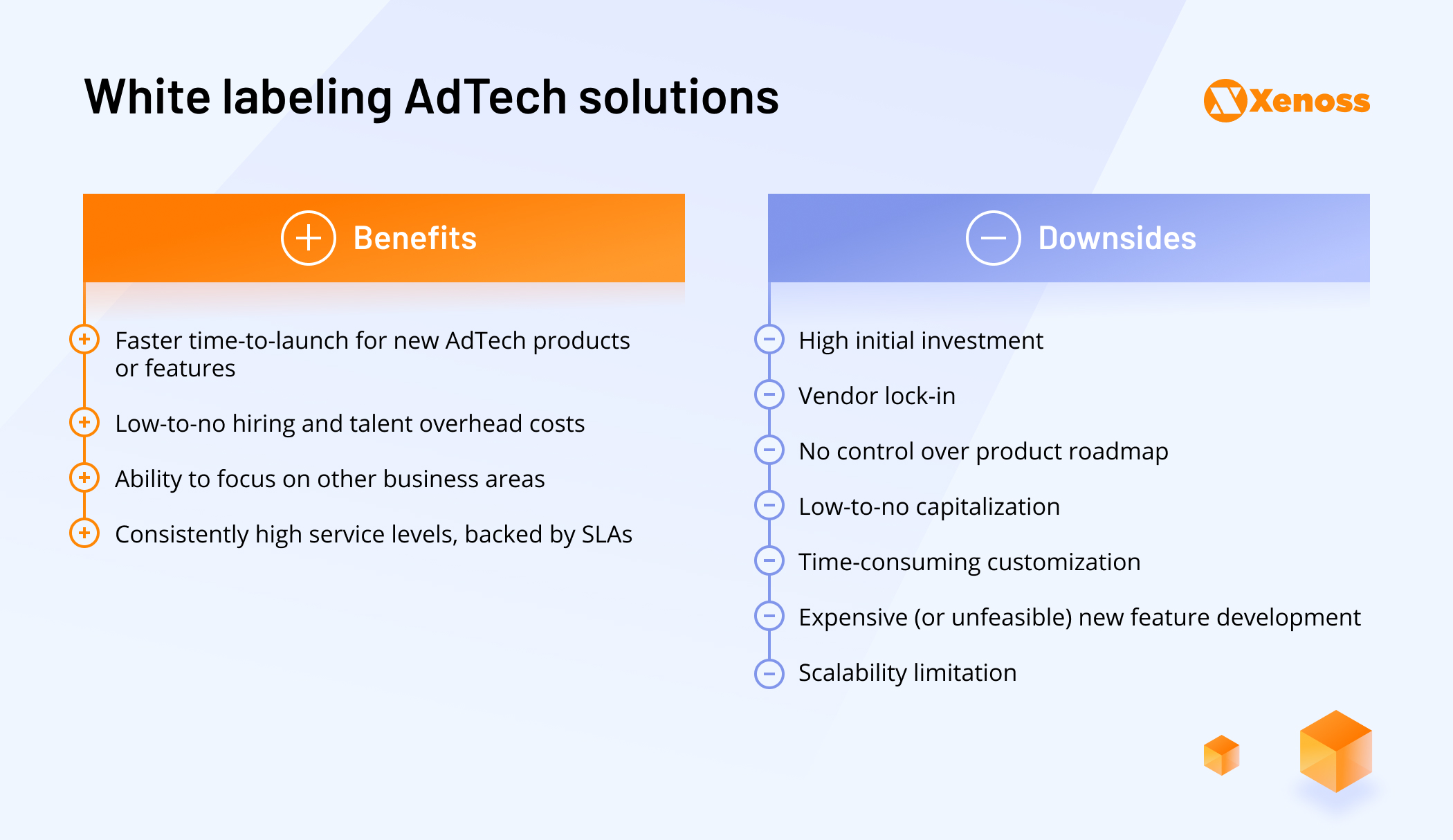
Read more about why you shouldn’t use white-label for AdTech development.
Custom software development partners
Custom software development companies, such as Xenoss, provide end-to-end support for AdTech product development, collaborating with clients throughout the entire software development process, from initial planning to final deployment and ongoing maintenance.
In such outsourcing partnerships, the customer shares specific requirements for the AdTech product development, while the development partner provides the technical expertise and human resources to deliver the said project. In this case, you’re handing out an entire project, a set of features, or a specific function to a third-party vendor who’s sitting in the driver’s seat (alongside your project stakeholders).
Unlike white-labeling, you get to maintain full control over the development roadmap (since you’re the visionary behind the product and dictate the key requirements, features, tech specs, etc). At the same time, you’re less involved in the day-to-day engineering team management compared to team extension.
The software development vendor commits to a specific timeline, makes tech stack recommendations, sets up the software development life cycle (SDLS), and ensures fast progress toward the set objectives.
In other words, you get a managed product development experience, plus you retain full IP/ownership rights over the final AdTech product.
Main stages of outsourcing AdTech software development
Main stages of outsourcing AdTech software development:
- Discovery is a methodical process for collecting and formalizing new software requirements (business, functional, and non-functional).
- Cross-functional team setup. Jointly, you decide on the optimal team composition for the project, and the vendor selects the best-fit candidates.
- Project planning involves the creation of reference architecture, a prioritized product backlog, and, subsequently — individual sprints.
- Product engineering and quality assurance (QA) is the hands-on stage where the software product takes shape. The hired team gets down to feature engineering and components testing.
- MVP (or pilot) product version release marks the end of the first product development lifecycle. At this point, you test the final product against the initial requirements and prepare for launch.
- Product scaling covers all subsequent work the software development vendor does (e.g., new feature development, extra integrations, infrastructure optimization, etc).
- Ongoing support and maintenance. You can also choose to outsource subsequent platform maintenance to the same team.
Software development partners can handle end-to-end product development of a specific project. Or work alongside your in-house units on more complex products. Such parallelization enables higher development velocity. You can allocate in-house resources toward maintaining and scaling the core product while an outsourced team works on building new product functionality.
Likewise, an experienced vendor can pick up projects that went amiss. For example, Ad-Lib faced challenges with its creative management platform development. The original architecture design proved ineffective, causing multiple glitches on the support side. Xenoss performed an effective rescue mission for the project and helped Ad-Lib finalize the product roadmap, overhaul the unstable MVP platform version, and upgrade to a cost-effective, scalable infrastructure in just 4 months.
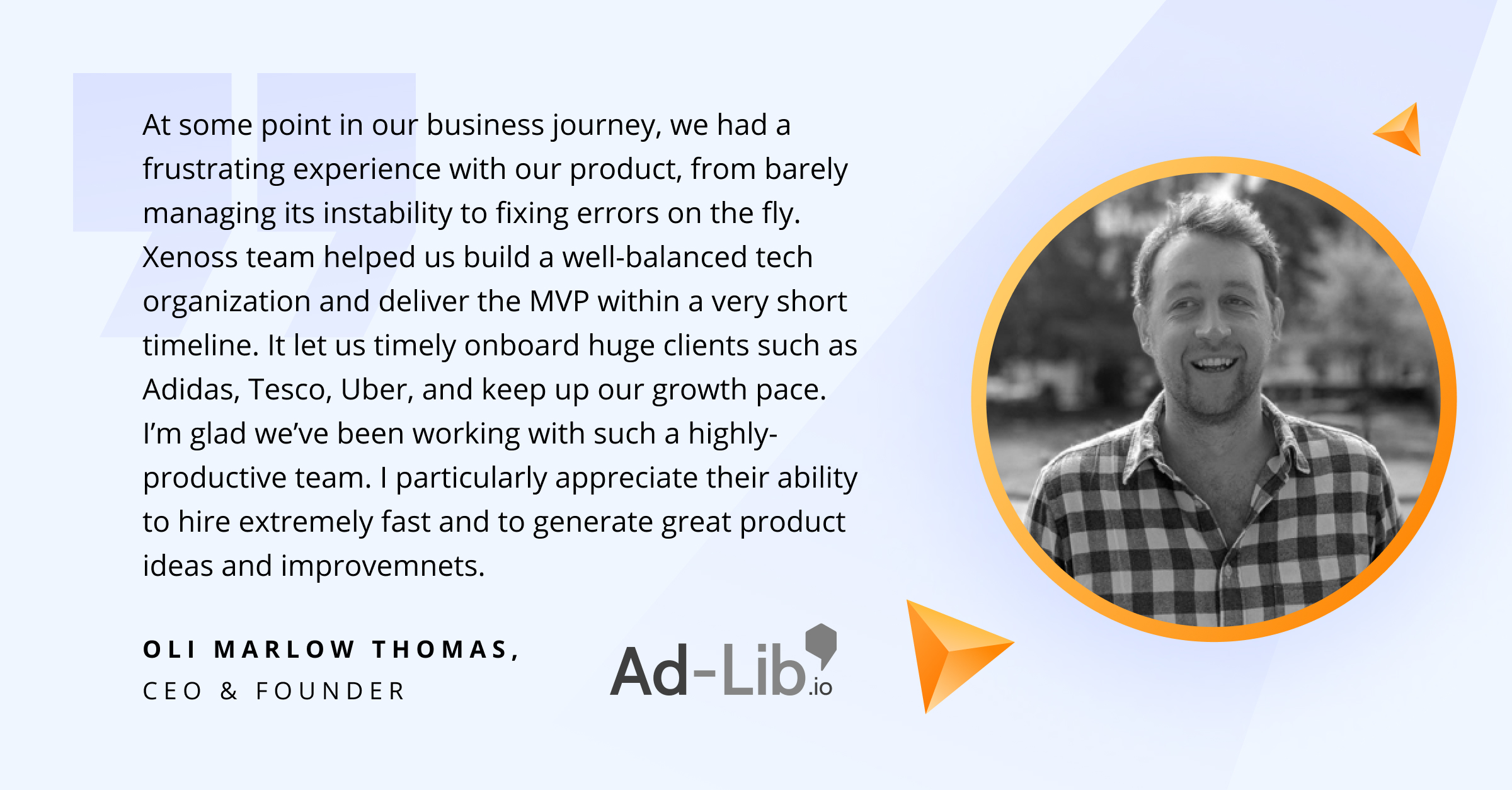
Afterward, we also helped Ad-Lib implement AI models for predicting the performance of different image and video creative assets. Shortly, Ad-Lib became the preferred CMP for brands like Tesco, Adidas, and Johnson & Johnson, among others.
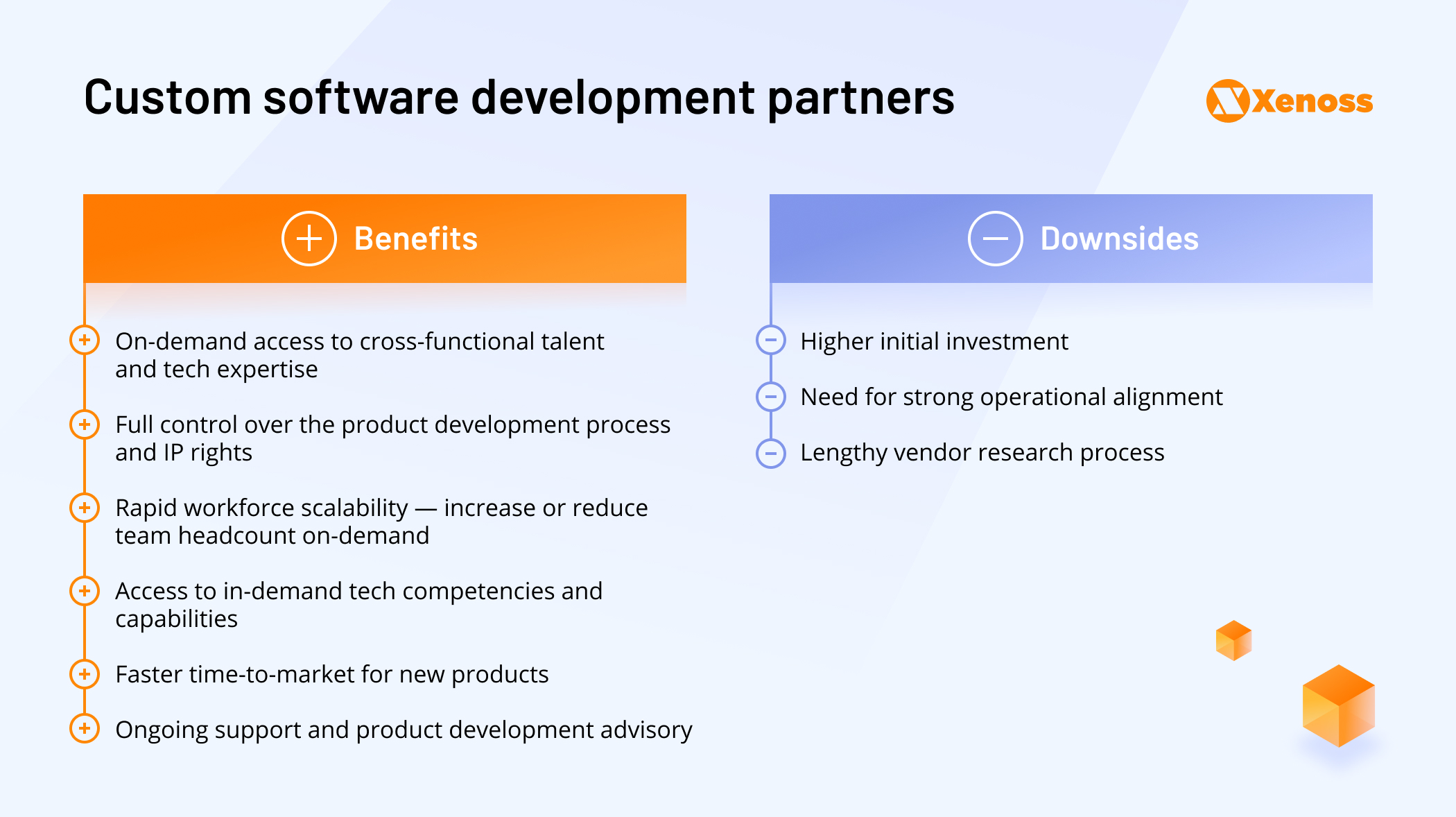
Final thoughts
The AdTech sector (as Big Tech at large) is in a tough position.
Product engineering, infrastructure maintenance, and data management workloads remain substantial. The acceptable time-to-market for new product features has shrunk, too. Yet, corporate human resources are strained.
Soundly, there are solid alternatives to growing the in-house headcount: Team augmentation, white-labeling, and strategic partnerships with software development vendors.
The most successful tech companies now operate as an integrated ecosystem of internal and external talent, where each side supports and reinforces the one another. Beyond staffing, partnerships with custom software development vendors provide companies with extra industry, technology, and process knowledge, aka all the elements you need to cruise smoothly through the volatile markets.
Whether you’re in the market for a new vendor or casually wondering if a software development partnership would work for your company, talk to the Xenoss team. We will be happy to explain how it all works and whether the outsourcing model fits your business needs. Request a free consultation.


